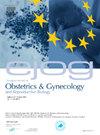Predictors of vasovagal symptoms or syncope during outpatient diagnostic hysteroscopy: A prospective observational study
IF 2.1
4区 医学
Q2 OBSTETRICS & GYNECOLOGY
European journal of obstetrics, gynecology, and reproductive biology
Pub Date : 2025-03-20
DOI:10.1016/j.ejogrb.2025.03.044
引用次数: 0
Abstract
Objective
To analyze factors conditioning the apparition of vasovagal prodromic symptoms or vagal syncope during or immediately after a diagnostic hysteroscopy performed in an outpatient setting.
Study Design
Prospective observational study including 1255 patients who received an outpatient diagnostic hysteroscopy in the Hysteroscopy Unit of Quirón Dexeus University Hospital, Barcelona, Spain since April 2019 until December 2021. Data such as fasting, smoking, analgesic or anxiolytic treatment intake, parity and menopausal status were collected. Patients with pathologies or treatments that could modify pain tolerance were excluded.
Results
Mean age was 42.7 ± 9.03 years. An 84.3 % of patients were premenopausal, while 15.7 % were smokers and 59 % of them had smoked 30 min before the procedure. Thirty-three point three percent of patients were fasting and 56.5 % had taken analgesic or anxiolytic pre-medication. A total of 79 patients (6.3 %) developed symptoms of vasovagal reaction. Pain was reported as 7.56 ± 1.97 in the Visual Analogic Scale (VAS) in patients with vagal symptoms versus 4.95 ± 2.66 in patients without vagal symptoms (p < 0.001). In the multivariate logistic model only a higher VAS score and a previous history of vasovagal symptoms during medical procedures were associated to a higher probability of developing vagal symptoms after adjusted by covariates [Odds Ratio (OR): 1.67 (95 % confidence interval (CI):1.45;1.93), OR:3.44 (95 % CI: 2.04;5.79) respectively].
Conclusions
When performing an outpatient hysteroscopy, patients should be asked about their previous history of vagal symptoms during medical procedures. Painful procedures should be immediately stopped in order to prevent discomfort, avoid the apparition of vagal prodromes or syncope and improve satisfaction with the procedure.
求助全文
约1分钟内获得全文
求助全文
来源期刊
CiteScore
4.60
自引率
3.80%
发文量
898
审稿时长
8.3 weeks
期刊介绍:
The European Journal of Obstetrics & Gynecology and Reproductive Biology is the leading general clinical journal covering the continent. It publishes peer reviewed original research articles, as well as a wide range of news, book reviews, biographical, historical and educational articles and a lively correspondence section. Fields covered include obstetrics, prenatal diagnosis, maternal-fetal medicine, perinatology, general gynecology, gynecologic oncology, uro-gynecology, reproductive medicine, infertility, reproductive endocrinology, sexual medicine and reproductive ethics. The European Journal of Obstetrics & Gynecology and Reproductive Biology provides a forum for scientific and clinical professional communication in obstetrics and gynecology throughout Europe and the world.

 求助内容:
求助内容: 应助结果提醒方式:
应助结果提醒方式:


